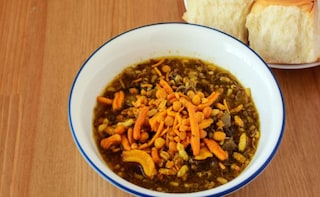I moved to Mumbai soon after I started my career in market research, close to twenty years back.I had spent a few months in an office in Kolkata before that. The head of the office there loved food (show me a Bengali who doesn't) and there was always great food in office - in the canteen, to order if at work after office hours and at parties. This was a completely different life after my frugal existence in college. It soon showed on my waistline. Mumbai was different. The focus was on work and just work. The office was larger and more impersonal. The office head was not really interested in food unlike his bhojon bilashi (food maven) Kolkata counterpart. It showed in the indifferent food in the canteen here.
I later realized that I had heard wrong and what I had eaten was actually the famous 'misal pav' of Mumbai. The office was at Dadar, the Maharashtrian heartland of Mumbai, and it was apt that misal, a Marathi favourite, was part of the daily canteen menu. I later worked in another market research office and was based at Parel, again a Maharashtrian dominated area of Mumbai.There weren't too many restaurants around except one called New Sardar (not to be confused with Sardar pav bhaji). The owner, a loquacious gentleman named Vivek Prabhu, was very proud of his misal pav which had won a local award too. Quite an enterprising man, Mr. Vivek hit upon the idea of delivering misal to your desk if you couldn't go to his restaurant. He would send it in the famous Bombay dabba tiffin containers. The misal was kept in the bottom compartment, pav in the next, then the farsan and the onions in the top most one. His missal was spicy and of pretty good quality. Would cheer me up at work but never give me heartburn. I moved on after a couple of years and New Sardar is now shut too. I don't think the two events are linked even though I was quite a frequent misal customer there.
Turns out that like the batata vada, the misal, was originally eaten in Maharashtrian families by itself or with rotis or flat-breads. Pav was a Portuguese introduction. Maharashtrian food blogger, Saee Koranne Khandekar points out that pav was originally not eaten in local Hindu houses as they (pavs) were considered to be 'alcoholic', toddy being used to ferment them. It was in the latter part of the 20th century that enterprising folks served misal with pav and batata vada in pav for the mill workers of Mumbai leading to their becoming a part of the city's street food scene.Last year I had to nominate dishes from Mumbai for the Foodie Hub Food Awards. After much deliberation, I nominated the misal pav from Suryakant Sarjoshi's 30 year old Aaswad restaurant in Dadar for the best vegetarian dish award. I did so as I feel that the misal is a dish which represents the Maharashtrian community of the city. It's versatile as it is found at home and on the streets. It's cheap, fueling the worker bees of the city. I am quite fond of the Aaswad version with its moderately spicy and non-oily misal with very fresh farsan and often stop there for misal when in Dadar. A Maharashtrian food blogger friend, who blogs at Sassy Fork, told me that Aaswad is her go-to place for Maharashtrian food. It is my favourite too now.The misal of Aaswad went on to win the best vegetarian dish in the Foodie Hub Global Awards in 2015 and people can't seem to get enough of it since.
Image Credit: Istock/ ashjadaziz
I later realized that I had heard wrong and what I had eaten was actually the famous 'misal pav' of Mumbai. The office was at Dadar, the Maharashtrian heartland of Mumbai, and it was apt that misal, a Marathi favourite, was part of the daily canteen menu. I later worked in another market research office and was based at Parel, again a Maharashtrian dominated area of Mumbai.
Advertisement
Photo credit: Istock/ NehaAurangabadkar
Turns out that like the batata vada, the misal, was originally eaten in Maharashtrian families by itself or with rotis or flat-breads. Pav was a Portuguese introduction. Maharashtrian food blogger, Saee Koranne Khandekar points out that pav was originally not eaten in local Hindu houses as they (pavs) were considered to be 'alcoholic', toddy being used to ferment them. It was in the latter part of the 20th century that enterprising folks served misal with pav and batata vada in pav for the mill workers of Mumbai leading to their becoming a part of the city's street food scene.Last year I had to nominate dishes from Mumbai for the Foodie Hub Food Awards. After much deliberation, I nominated the misal pav from Suryakant Sarjoshi's 30 year old Aaswad restaurant in Dadar for the best vegetarian dish award. I did so as I feel that the misal is a dish which represents the Maharashtrian community of the city. It's versatile as it is found at home and on the streets. It's cheap, fueling the worker bees of the city. I am quite fond of the Aaswad version with its moderately spicy and non-oily misal with very fresh farsan and often stop there for misal when in Dadar. A Maharashtrian food blogger friend, who blogs at Sassy Fork, told me that Aaswad is her go-to place for Maharashtrian food. It is my favourite too now.
Advertisement
Advertisement
Advertisement
For the latest food news, health tips and recipes, like us on Facebook or follow us on Twitter and YouTube.
Advertisement
